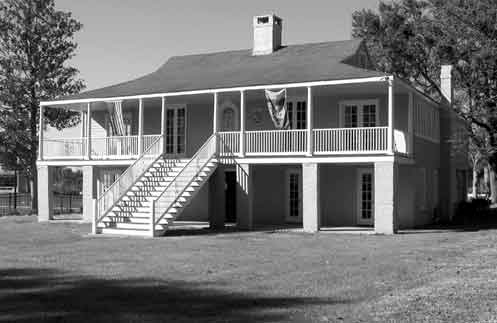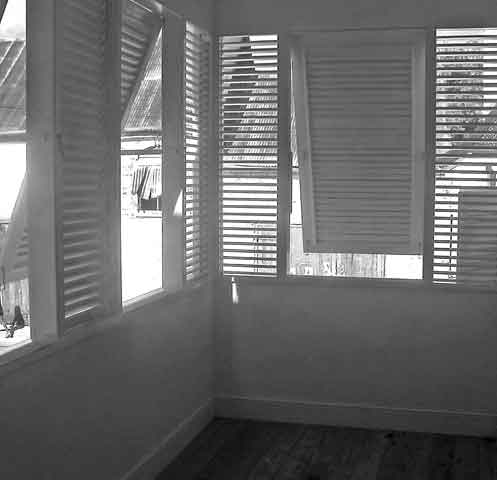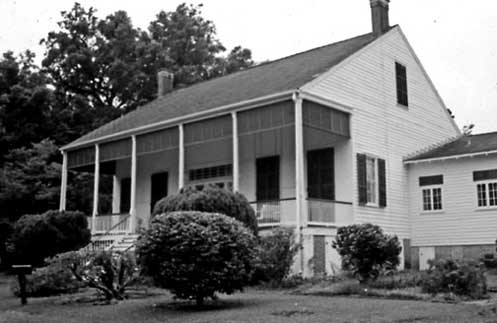The Art/Architectural History Approach to Material Culture Studies
Philippe Osźuścik, University of South Alabama
My casual observations entail two approaches to the study of material culture from my field of art and architectural history: first, the educational preparation provided to my generation during the 1960s, to which the greater part of this paper is dedicated; and second, the preparation provided to today’s students in the school of art and architectural history. The reason for dual observations is that both approaches are taken today. On the undergraduate survey level, both programs focus on a Darwin-like evolution of styles and technology in cultures and periods of western civilization. However, a major in American art and architecture provides a more pragmatic coverage of the arts and crafts, a material culture approach. The British colonies are emphasized and an evolution of styles and technology from vernacular beginnings to famous architects, artists, and movements of the twentieth century are introduced to students.
At the graduate level, I had training in both an art history department and the school of architecture and feel that I can briefly speak about different approaches that existed in the respective programs during the sixties. I noted that undergraduate students in architecture were exposed to the history of architecture to understand their historical knowledge of structural technologies as well as historical styles. Sigfried Giedion’s Space, Time and Architecture was a paradigm to illustrate how the technologies and historical styles logically ended up with the Modernist Style. With emphasis on modernism, the halls seemed to echo, “Form follows function” because modernism dominated design instruction in architectural school. In the age of “urban renewal” issues such as preservation and adaptive reuse had not been conceived in architectural educational programs.
One problem of the art and architectural approach during the sixties is that the focus of texts was too narrow by introducing students to only the greatest monuments and architects which actually comprise only about two percent of all existing buildings. A student was not prepared to research the real vernacular world. My master’s research emphasized buildings built by city and parish governments during the 1850s in Baton Rouge. Thus, I immediately realized that my knowledge of the great mansions and architects of the world were of little use to me other than recognizing revival styles, a major emphasis to the discussion of nineteenth century architecture at that time. In Baton Rouge, James Dakin is the only professional architect who was covered in textbooks with his design and construction of the Old Louisiana Capitol, 1847-52.
However, the art and architectural approach did prepare me adequately for the structural and stylistic analyses needed. I learned to measure and draw the plans of structures in the field and examine the details of materials and hardware. I was taught how to utilize the original documents of courthouses, state archives, church and civic board minutes, city directories, local newspapers, and architectural handbooks, among others. My research revealed names of local contractors, and builders who had become forgotten over the generations.
My personal career was launched by having excellent professors in art history and architectural history at Louisiana State University, both knowledgeable about vernacular architectural traditions of Anglo and French Louisiana due to their active research in the Baton Rouge region. Their insights were not found in texts of the time and so my introduction to vernacular traditions came by way of two professors who gave me encouragement in my research. However, all scholarly fields in material culture rely upon the personal knowledge of professors to advance their students beyond the content of texts.
To be fair to students of American art and architecture, a major advantage in their training exists. Since the United States began with a series of European colony settlements, the Americanist always realized the importance to recognize ethnic traits in architecture and in all of the arts and crafts produced in the respective colonies. With the emphasis going to the British, students are exposed to differing regional traditions that developed in the Southeast, Mid-Atlantic, and Northeast colonies.
The dominant emphasis given to the Anglo colonies during the sixties also created a weakness, resulting from only about ten pages devoted to the Spanish efforts in Florida, Texas, New Mexico and California combined; about two or three pages to the French in the United States; and about the same to the Dutch and Germans. Scots, Finns, Swedes and other ethnicities were mentioned more as a marginal note. Unless a student specialized in British colonies in the United States, a researcher interested in any of the other ethnicities was left to his or her own resources because few articles were available. Those of us interested in Louisiana, for example, had to explore the entire cultural history through documents and books of other disciplines to become proficient in analyzing the few remaining surviving artifacts.
My interest in French Creole research began as a graduate student in Baton Rouge and my first teaching job in Natchitoches, Louisiana. I found the writings of Samuel Wilson useful; but interestingly, art historians and architectural historians did not introduce me to the writings of Fred Kniffen, Henry Glassie and other valuable researchers concerning folk house types. Their articles came to my attention through reprints in books and in bibliographies. The same is true for the late Charles Peterson, a historian who had articles and chapters in scholarly books, such as, The French in the Mississippi Valley, 1965. While architectural texts favor his 1941 theory about the evolution of French Creole housing in the Illinois, the texts do not openly credit him for his theory. These scholars and more guided my research in history, cultural geography, cultural anthropology, and historical archaeology and other fields to gain a rounded knowledge about the French Creole cottage. By the 1970s I generally regarded these fields to have much to offer in vernacular house research than art history and that a multi-disciplinary approach is the correct approach to the study of vernacular housing. I also learned that our vocabulary in the discussion of house types is sometimes different, to which I will devote a little time momentarily.
My final transition to a multi-disciplinary approach to vernacular architecture was made by becoming an NEH Summer Seminar fellow at the University of Texas, directed by John Vlach, an eminent scholar in the field of Folklife Studies. He expanded my knowledge of Folklore, Folklife, Vernacular Architecture to the point of inspiring me to conduct research in the West Indies. I discovered that Haiti was most important with my personal interests and I felt exhilarated about sampling Creole foodways, working with a Creole guide and translator, attending a Legba Voodoo ceremony, studying both urban and rural structures I encountered. After going to Haiti’s American Museum of Art, I began collecting Creole sculptures, paintings, and crafts. I had always liked to cook Creole recipes but I took special interest in the ingredients, noting that a more African, spicy cuisine existed in South Haiti compared to a more French Creole cuisine in North Haiti that resembled a New Orleans style. Through the Haitian experience and the Folklife Seminar, I learned that the entire material culture of a folk tradition is important to absorb and to understand when studying a house tradition.
During the early 1980s I broadened my research to include Hispanic and British Caribbean influences on the Gulf Coast. The broader interests involve ever more complications in the creolization on the North Gulf Coast where the Spanish, French, British, and Native Americans “exchanged” ideas. These exchanges existed despite that fact that these Europeans were often enemies and officially told not to trade or make peace with their opponents. My studies indicate that they had an active black market trade and that ideas flowed from one colony to another. After Acadians and later Americans arrive, the “gumbo” became even thicker and spicier.
Earlier I mentioned that terminology differences exist between disciplines. To illustrate the point I wish to reveal an embarrassment that occurred at a professional meeting a quarter century ago. I was criticized for using the word, “creolization,” in my paper. Why? The word was not in a standard dictionary. Sure enough, the noun was not to be found in the dictionary and all that I was merely trying to avoid was a redundant use of the term, syncretism, in every paragraph. I borrowed “syncretism” from an article by the cultural anthropologist, Jay Edwards, “Simple and Complex Syncretisms.” I found that his interest in the study of Creole housing parallels mine in our search for the origins of Creole architectural traditions. I found it interesting that he used a term favored by the field of philosophy to explain the merging of different folk traditions in the Caribbean. I noted that other experts use other terms, such as amalgamation, a term favored in the business world. Sociologists like the term assimilation. It is worth emphasizing that all of these disciplines used the terms in discussions about Creole housing in their respective disciplines. By the mid-1990s (and to my delight), historic archaeologists were freely using the term, “creolization” in their explanation of Anglo-American structures and Afro American structures in the Southeast Atlantic states and in Jamaica containing Creole elements. I really feel redeemed that Jay Edwards acknowledged the word in A Creole Lexicon (Edwards 2004, 76). The lesson here is that all scholars who are pushing research into new frontiers, find situations that call for the creation of terms previously not used.

Figure 1. Gable-on-hip roof, Vincent House, Mobile, Alabama, 1828. All photographs by Philippe Osźuścik.
Sometimes, the different disciplines of scholars of material culture use different words for the same term which can be confusing, such as two rooms deep or double pile for an easy example; or a pent roof, also called a visor roof. At times, scholars of the same discipline but in different regions or countries use different terms for the same item. American Creole scholars like to identify a roof type (figure 1) as being a “gable-on-hip roof,” but in England, the same roof form is called a “hip-on-gable roof”; but the English also drive on the opposite side of the highway. One of my favorite discoveries is that one type of shutter (figure 2) found on postmodern buildings in Alabama that are top-hinged, are called “Key West” shutters. However, in Key West this shutter is called a Bermuda Shutter. Needless to say, in Bermuda, the locals refer to the shutter as a Demerara Shutter and refer to Barbados as its origin. At least we are getting closer to the truth, because in Barbados, the same term is used but Barbadians acknowledge the Demerara Province of Guyana as the origin for this type of shutter. One last quick comparison of terms also relates to Creole cottages. The integral gallery (figure 3) is also called: incised porch, recessed porch, or simply gallery, piazza, porch or verandah.

Figure 2. Demerara Shutter, Arlington House, Barbados, seventeenth century (for the house).

Figure 3. Integral Gallery, Gaillard House, Mobile, Alabama, 1836.
I have been discussing Material Culture Studies from my personal training in art and architectural history, followed by expanding my knowledge through other material fields and personal investigations. At this point I wish to make note of a newer approach to teaching American Art and Architecture. Present texts in American art and architecture are taking a broader, cultural approach, such as American Encounters: Art, History, and Cultural Identity (Miller et al 2008); and the new edition of American Architecture: A History, by Leland M. Roth (2001). A theme in Roth is devoted to “transplanted vernaculars” by Europeans in the New World. A long chapter is devoted to Native Americans. Each chapter of the Anglo developments now ends with vernacular themes, such as the rural landscape, the introduction of new vernacular house forms, and factories and factory housing, among others, in its search for an American architecture. A building is still seen as a primary document in research but not isolated by itself. The structure is a part of the built material landscape that mirrors its culture’s beliefs at a certain time period.
I believe one central reason that the American art and architectural curriculum has recently explored vernacular developments is the relatively new field of preservation. Today’s students are being provided with a more realistic encounter of structures in their built environment from pen houses, contractor-guide books, to factories and barns. I believe that all of the disciplines I mentioned share a similar interest to prepare their students for the preservation field. While a major in preservation was a rarity before our bicentennial year of 1976; today, every state has multiple programs from which to choose.
While there were always some American house style guide books, there are better and more reference books that include vernacular traditions as well as historical styles, such as Virginia and Lee McAlester’s A Field Guide to American Houses (1997), that are good for students entering the field of American architecture and preservation. Jan Jennings and Herbert Gottfried (1988), American Vernacular Interior Architecture: 1870—1940, is an illustrated handbook, divided by architectural elements, support systems, design systems, and building types. It is worth mentioning, the Encyclopedia of Southern Culture, 1989, and Jay Edwards, A Creole Lexicon. While today’s reference books are preparing students for Material Culture Studies better than in the past, gaps still exist between the disciplines and that a multi-disciplinary approach. Many of the gaps are being filled in by expert researchers who are writing on subjects of material culture not touched before. Too numerous to list, I will mention a few publications by Vernacular Architecture Forum and Pioneer America Society members. Among them should be mentioned Allen Noble’s To Build in a New Land: Ethnic Landscapes in North America (1992), and the PAS multi-volume publication of The National Road, 1996, which investigated a cross-country landscape. John Rehder’s Louisiana’s Vanishing Plantation Landscape (1999) investigated a regional landscape and way of life which has continued to vanish. With pride, I can state that scholars of Material Culture and Vernacular Studies have produced many of the award winning, scholarly architectural books during the last quarter-century.
I end with a little advice. It is important for a student in any of the professional fields possessing an interest in Material Culture to investigate the vernacular interests of its faculty and to ascertain that the school of choice has individuals with expertise and interests that match those of the prospective student, and that the expertise extends beyond general textbooks. With this approach to finding the perfect graduate and post-graduate program, I feel that the generation entering our field today will be able to produce further achievements in the near future.
References Cited
Edwards, J. 2004. A Creole Lexicon. Baton Rouge: Louisiana State University Press.
Jennings, J., and H. Gottfried. 1988. American Vernacular Interior Architecture: 1870-1940. Ames: Iowa State University Press.
McAlester, V., and L. McAlester. 1997. A Field Guide to American Houses. New York: Alfred A. Knopf.
Miller, A., J. C. Berlo, B. Wolf, and J. L. Roberts. 2008. American Encounters: Art, History, and Cultural Identity. Upper Saddle River, NJ: Prentice Hall.
Noble, A. 1992. To Build in a New Land: Ethnic Landscapes in North America. Baltimore: Johns Hopkins University Press.
Rehder, J. 1999. Delta Sugar: Louisiana’s Vanishing Plantation Landscape. Baltimore: Johns Hopkins University Press.
Roth, L. 2001. American Architecture: A History. Boulder, CO: Westview Press.
Reagan, C. W., and W. Ferris, eds. 1989. Encyclopedia of Southern Culture. Chapel Hill: University of North Carolina Press.

